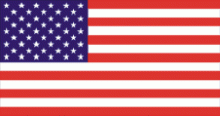|
American Flag
|
The Flag of the United States of America consists of 13 equal horizontal stripes of red (top and bottom) alternating with white, with a blue rectangle in the canton bearing 50 small, white, five-pointed stars arranged in nine offset horizontal rows of six stars (top and bottom) alternating with rows of five stars. The 50 stars on the flag represent the 50 states and the 13 stripes represent the original Thirteen Colonies that rebelled against the British crown and became the first states in the Union. Nicknames for the flag include "the Stars and Stripes", "Old Glory", and "the Star-Spangled Banner". Because of its symbolism, the starred blue canton is called the "union". This part of the national flag can stand alone as a maritime flag called the Union Jack which served as the United States jack on warships from 1777 until 2002. United States warships now display as a jack, the Culpepper Ensign, which is displayed here. The blue canton continues to be used as a jack, however, by various federally-owned vessels, including those of the Coast Guard, Military Sealift Command, and National Oceanic and Atmospheric Administration. History of The Flag The flag has been changed 26 times since the new, 13-state union adopted it. The 48-star version went unchanged for 47 years, the longest time the flag went unmodified until July 4, 2007, when the current 50-star flag broke the record. First Flag At the time of the signing of the Declaration of Independence, July 4, 1776, the United States had no official national flag. The Grand Union Flag, displayed here, has historically been referred to as the "First National Flag". Although it has never had any official status, it was used throughout the American Revolutionary War by George Washington and formed the basis for the design of the first official United States flag. The origins of the flag's design are unclear. It closely resembles the British East India Company (BEIC) flag of the same era, and an argument holds that the BEIC flag indeed inspired the design. The BEIC flag could have from 9 to 15 stripes, however, and was not allowed to be flown outside the Indian Ocean. Another theory holds that the red-and-white stripe and later, stars-and-stripes motif of the flag may have been based on the Washington family coat-of-arms, which consisted of a shield "argent, two bars gules, above, three mullets gules" (a white shield with two red bars below three red stars). This is the design of the flag of the District of Columbia. More likely it was based on a flag of the Sons of Liberty, one of which consisted of 13 red and white alternating horizontal stripes. The Flag Resolution of 1777 On June 14, 1777, the Second Continental Congress passed the Flag Resolution which stated: "Resolved, That the flag of the United States be thirteen stripes, alternate red and white; that the union be thirteen stars, white in a blue field, representing a new Constellation." Flag Day is now observed on June 14 of each year. The Flag Resolution did not specify any particular arrangement for the stars. The so-called Betsy Ross Flag (with the thirteen stars arranged in a circle), although never an official flag, is the oldest version of any United States flag to appear on any physical relic: it is historically referenced in contemporary battlefield paintings by John Trumbull and Charles Willson Peale, which depict the circular star arrangement. Popular designs at the time were varied and most were individually crafted rather than mass-produced. Given the scant archaeological and written evidence, it is unknown which design was the most popular at that time. The origin of the stars and stripes design is uncertain. A popular story credits Betsy Ross for sewing the first flag from a pencil sketch by George Washington who personally commissioned her for the job. No evidence for this theory exists, however, beyond Betsy's descendants' much later recollections of what she told her family. Another woman, Rebecca Young, has also been credited as having made the first flag by later generations of her family. Rebecca Young's daughter was Mary Pickersgill, who made the Star Spangled Banner Flag. Another, more likely, popular theory is that the flag was designed by Congressman Francis Hopkinson. Hopkinson was the only person to have made such a claim during his own lifetime, when he sent a bill to Congress for his work. Initially, he asked for a "Quarter Cask of the Public Wine" as payment. The payment was not made, however, because it was determined he had already received a salary as a member of Congress, and he was not the only person to have contributed to the design. It should be noted that no one else contested his claim at the time. Later Flag Acts In 1795, the number of stars and stripes was increased from 13 to 15 (to reflect the entry of Vermont and Kentucky as states of the union). For a time the flag was not changed when subsequent states were admitted, probably because it was thought that this would cause too much clutter. It was the 15-star, 15-stripe flag that inspired Francis Scott Key to write "The Star-Spangled Banner," now the National Anthem. On April 4, 1818, an act was passed by Congress at the suggestion of Captain Samuel C. Reid, United States Navy, in which the flag was changed to have 20 stars, with a new star to be added when each new state was admitted, but the number of stripes would remain at thirteen to honor the original colonies. The act specified that new flag designs should become official on the first July 4 (Independence Day) following admission of one or more new states. Neither the order of the stars nor the proportions of the flag was prescribed until President Taft's Executive Order of June 24, 1912, which provided for the arrangements of the stars in horizontal rows. Consequently, flags dating before this period sometimes show unusual arrangements of the stars and odd proportions, these features being left to the discretion of the flag maker. In general, however, straight rows of stars and proportions similar to those later adopted officially were used. Future of the Flag The United States Army Institute of Heraldry has plans for flags with up to 56 stars, using similar staggered star arrangements should additional states accede. |

